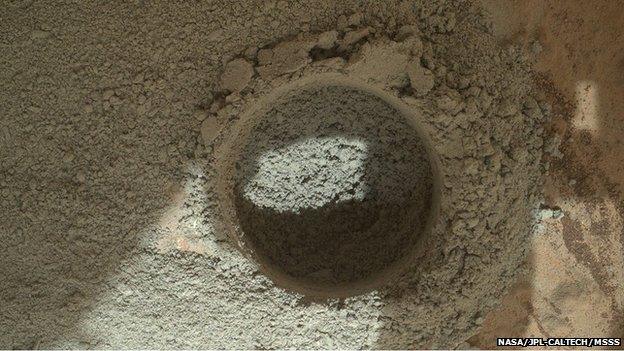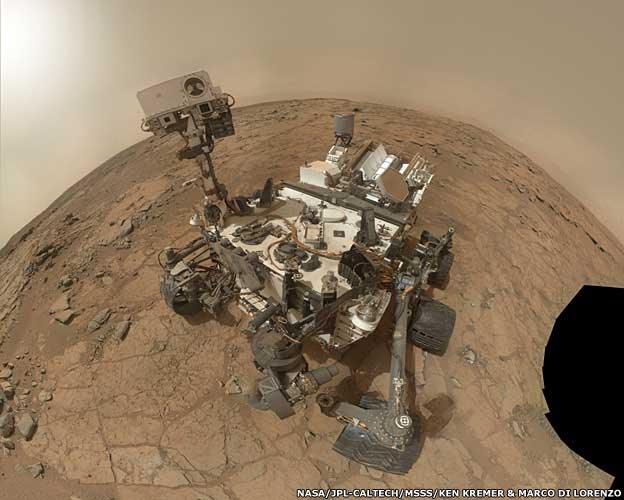Curiosity Mars rover spins its rock drill
- Published

Curiosity drills a hole that is 16mm across (5/8inch).
Nasa's Mars rover Curiosity has turned its drill in rock for the first time.
The big rover had previously used just the hammer action on the tool, but it has now progressed to operating the device in a rotary mode as well.
New pictures sent back from the robot show a small, shallow, rounded hole that is surrounded by fine tailings.
Soon, Curiosity, external will be commanded to drill up to 5cm into rock to obtain a powdered sample that can be delivered to the vehicle's onboard labs.
Engineers at the US space agency continue to take a slow, stepwise approach to the introduction of the tool.
They want to be sure that the device is behaving as designed and that the rock chosen for drilling is not responding in some unexpected way that could result in damage.
Drilling is absolutely central to Curiosity's mission in Gale Crater, the deep equatorial bowl where it landed last August.
The rover is investigating whether past environments at this location could ever have supported life, and getting inside rocks to analyse their chemistry will provide some of the most telling evidence.
The flat slabs of rock currently being worked by the rover have been dubbed "John Klein", the name of a deceased Curiosity engineer.
They lie in a small depression referred to as Yellowknife Bay, about half a kilometre from the robot's point of touchdown last year.
The John Klein slabs contain very fine-grained sediments but are cut through with pale veins of what could be calcium sulphate.
Curiosity will likely drill a number of shallow test holes, using the tailings to scrub the metal bit of any contaminants carried from Earth.
Eventually, though, the drill will go deep enough to push rock powder into the drill's sample-gathering chamber. From there, the powder will be sorted to the correct volume and particle size to go in the robot's Chemin and Sam labs.
The subsequent analysis will reveal the precise chemical and mineralogical compositions present in the powder, giving scientists clues as to the likely conditions under which the rock formed.
In recent days, the rover has also sent back the images to make another of its popular self-portraits.
These spectacular vistas are the product of the Mahli "hand lens" camera.
This is positioned on the same tool-turret as the drill, on the end of the robotic arm.
By extending the arm outwards and tuning Mahli back to look in the direction of the rover, a sequence of images can be acquired that anyone can then assemble into a large mosaic using the appropriate software.
The self-portrait on this page was built by Ken Kremer and Marco Di Lorenzo. You can see more examples of their work at Ken Kremer's website, external.

Jonathan.Amos-INTERNET@bbc.co.uk and follow me on Twitter: @BBCAmos, external
- Published4 February 2013
- Published15 January 2013
- Published8 January 2013
- Published4 January 2013
- Published3 January 2013
- Published4 December 2012
- Published4 December 2012
- Published10 September 2012
- Published6 August 2012
- Published25 May 2012